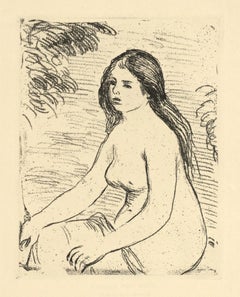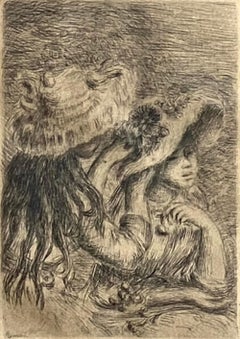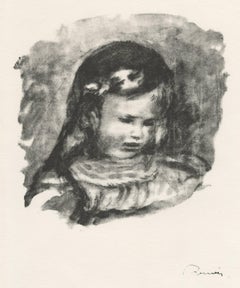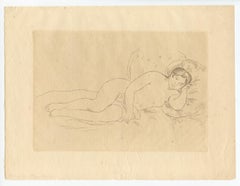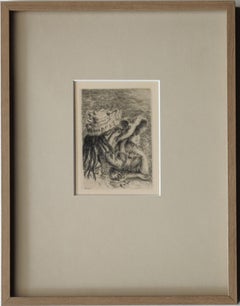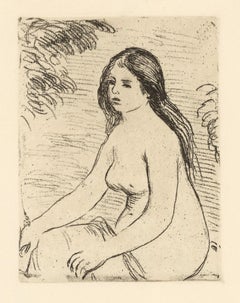Pierre-Auguste Renoir Art
An early 20th-century master, Pierre-Auguste Renoir created thousands of figurative prints and paintings and is credited as one of the founders of the Impressionist movement. His frequently reproduced works are appreciated for their luminous appearance, rich colors and soft, feathered brushstrokes.
Renoir was born in Limoges, France, in 1841. He began painting as a child while working in a porcelain factory, which led to a formal study of art in Paris under Charles Gleyre. In the early 1860s, he often visited the Louvre to study French master painters, and he became friends with Claude Monet and Alfred Sisley, both leading Impressionists.
Renoir first exhibited his paintings in 1864, but he did not rise to prominence until his first exhibition with the Impressionists in 1874. In 1877, Renoir stopped exhibiting with the Impressionists and embarked on a series of travels. In 1881, he went to Algeria and Spain, meeting the artists Eugène Delacroix and Diego Velázquez. He continued to Rome, Sicily, Algeria and Guernsey, where he created 15 paintings in one month in the summer of 1883.
In 1890, Renoir married Aline Victorine Charigot, a portrait model and muse for many of his works. They had three sons, and in 1907, Renoir moved his family to the village of Cagnes-sur-Mer, near the Mediterranean. By this time, he had developed arthritis in his hands, and he had a stroke in 1912, after which he used a wheelchair. Renoir continued to paint for the rest of his life, even strapping a brush to his paralyzed fingers.
Shortly before his death in 1919, Renoir visited the Louvre to see his paintings now hanging next to the artistic icons that he used to study and admire. He returned to his home village and died in December of that year.
On 1stDibs, find Pierre-Auguste Renoir paintings, prints and sculptures.
Early 1900s Impressionist Pierre-Auguste Renoir Art
Etching
1880s Impressionist Pierre-Auguste Renoir Art
Archival Paper, Etching
Early 1900s Impressionist Pierre-Auguste Renoir Art
Lithograph
Early 1900s Impressionist Pierre-Auguste Renoir Art
Etching
1890s Pierre-Auguste Renoir Art
Etching
Early 1900s Impressionist Pierre-Auguste Renoir Art
Etching
1890s Pierre-Auguste Renoir Art
Etching
1890s Art Nouveau Pierre-Auguste Renoir Art
Etching
Early 1900s Post-Impressionist Pierre-Auguste Renoir Art
Canvas, Oil
1910s Impressionist Pierre-Auguste Renoir Art
Etching
1910s Impressionist Pierre-Auguste Renoir Art
Bronze
1890s Impressionist Pierre-Auguste Renoir Art
Etching
1910s Impressionist Pierre-Auguste Renoir Art
Etching
Early 1900s Impressionist Pierre-Auguste Renoir Art
Etching
20th Century Pierre-Auguste Renoir Art
Drypoint
1910s Impressionist Pierre-Auguste Renoir Art
Lithograph
1890s Impressionist Pierre-Auguste Renoir Art
Lithograph
1890s Modern Pierre-Auguste Renoir Art
Lithograph
1910s Impressionist Pierre-Auguste Renoir Art
Etching
1910s Impressionist Pierre-Auguste Renoir Art
Lithograph
1890s Pierre-Auguste Renoir Art
Etching
Early 20th Century Impressionist Pierre-Auguste Renoir Art
Lithograph
Early 1900s Pierre-Auguste Renoir Art
Etching
1910s Impressionist Pierre-Auguste Renoir Art
Etching
1890s Art Nouveau Pierre-Auguste Renoir Art
Etching
1910s Pierre-Auguste Renoir Art
Drypoint
1910s Impressionist Pierre-Auguste Renoir Art
Etching
Early 1900s Modern Pierre-Auguste Renoir Art
Lithograph
1910s Impressionist Pierre-Auguste Renoir Art
Laid Paper, Lithograph
Early 1900s Impressionist Pierre-Auguste Renoir Art
Etching
1950s Modern Pierre-Auguste Renoir Art
Lithograph
1940s Pierre-Auguste Renoir Art
Lithograph
Early 1900s Impressionist Pierre-Auguste Renoir Art
Lithograph
Late 20th Century Pierre-Auguste Renoir Art
Lithograph
Late 20th Century Pierre-Auguste Renoir Art
Lithograph
18th Century Pierre-Auguste Renoir Art
Lithograph
Late 20th Century Pierre-Auguste Renoir Art
Lithograph
Early 1900s Pierre-Auguste Renoir Art
Etching
1910s Impressionist Pierre-Auguste Renoir Art
Paper, Etching
Early 1900s Modern Pierre-Auguste Renoir Art
Lithograph
1910s Impressionist Pierre-Auguste Renoir Art
Canvas, Oil
19th Century Impressionist Pierre-Auguste Renoir Art
Canvas, Oil
Pierre-auguste Renoir art for sale on 1stDibs.
Artists Similar to Pierre-Auguste Renoir
- 1stDibs ExpertNovember 20, 2024To tell if a painting is a Renoir, familiarize yourself with the artist’s signature by looking at examples on trusted online resources. Renoir did sign many of his works, often in an upper or lower corner. For unsigned works, it is necessary to look for the signature characteristics of the French Impressionist’s work. Among these are feathered or broken brush strokes, the use of vivid colors and his tendency to depict subjects engaging in leisure activities, often in outdoor settings. Because there are many convincing reproductions of Renoir's work, experts recommend consulting a certified appraiser or experienced art dealer when trying to authenticate a work that is potentially by the artist. On 1stDibs, shop a collection of Pierre-Auguste Renoir art.
- 1stDibs ExpertApril 5, 2022Bal at Le Moulin de la Galette is probably Renoir’s most well-known painting, but he has created many works of art that are considered masterpieces. Pierre-Auguste Renoir was a well-known French painter and part of the Impressionist movement before breaking off and working on more formal paintings and portraits. Shop a selection of Renoir pieces from some of the world’s top art dealers on 1stDibs.
- Is Renoir an Impressionist?1 Answer1stDibs ExpertFebruary 13, 2024Yes, Renoir is an Impressionist. An early 20th-century master, Pierre-Auguste Renoir, created thousands of figurative prints and paintings, and is credited as one of the founders of the Impressionist movement. His frequently reproduced works are appreciated for their luminous appearance, rich colors and soft, feathered brushstrokes. Shop a selection of Pierre-Auguste Renoir art on 1stDibs.
- 1stDibs ExpertApril 5, 2022Pierre-Auguste Renoir is known for his Impressionist paintings. His works reflect the interest in displaying the effects of light indicative of the movement. Some of the French artist's most famous works include Luncheon of the Boating Party, Two Sisters and La Grenouillère. You'll find a variety of Pierre-Auguste Renoir art on 1stDibs.
